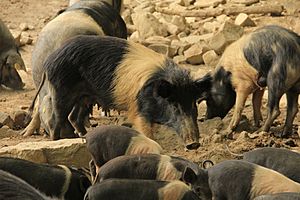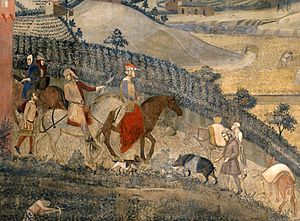Cinta Senese facts for kids
 |
|
| Conservation status | FAO (2007): endangered |
|---|---|
| Other names |
|
| Country of origin | Italy |
| Traits | |
| Weight |
|
| Notes | |
| Breed standard | |
|
|
The Cinta Senese is a special type of pig that comes from the province of Siena in Tuscany, a beautiful region in central Italy. These pigs are easy to spot because they have a unique look: a dark body with a light-colored band, or "cinta," around their middle. This band gives them their name, which means "Siena belt."
Since 2006, Cinta Senese pigs raised in Tuscany have had a special status called DOP. This means their meat is a protected product, similar to how certain cheeses or wines are protected. Their official name under this status is Suino Cinto Toscano DOP. The Cinta Senese is one of only six native pig breeds recognized by the Italian Ministry of Agriculture.
Contents
What Makes Cinta Senese Pigs Special?

Cinta Senese pigs are known for their unique appearance. They have a dark, often black, coat with a distinctive white or light-colored band that goes around their chest and front legs. This band looks like a belt, which is where the "cinta" (belt) part of their name comes from.
These pigs are quite large. Male Cinta Senese pigs can weigh up to 300 kilograms (about 660 pounds), while females can reach 250 kilograms (about 550 pounds). They are strong and hardy animals, well-suited to living outdoors.
Where Do Cinta Senese Pigs Live?
The Cinta Senese pig breed is especially connected to the Montagnola Senese area in Tuscany. This includes towns like Casole d'Elsa, Castelnuovo Berardenga, Gaiole in Chianti, Monteriggioni, Siena, and Sovicille. These areas are found between the upper parts of the Merse and Elsa rivers.
In the past, these pigs were common all over Tuscany. They are well-adapted to the local environment, often grazing in forests and open fields.
A Look Back in Time
A special record book, called a genealogical herdbook, was started for Cinta Senese pigs in the early 1930s. This book helped keep track of the pigs' family trees and important information about the breed.
However, after World War II, the number of Cinta Senese pigs dropped very quickly. They almost disappeared completely! Because there were so few pigs left, the herdbook was stopped in the 1960s.
Luckily, people worked hard to help the breed recover. Their numbers slowly started to grow again. Because of this recovery, the herdbook was re-opened in 1997. Today, the Associazione Nazionale Allevatori Suini, which is the Italian national association for pig breeders, keeps this important record.
Are They Still Endangered?
Even though their numbers have improved, the Cinta Senese pig breed is still considered rare. At the end of 2007, there were only about 2,867 of these pigs. Because of their low numbers, the Food and Agriculture Organization (FAO) listed the breed as "endangered" in the same year.
By the end of 2012, there were 2,543 pigs registered across 111 farms. Efforts continue to protect and grow the population of this unique Italian pig breed.


